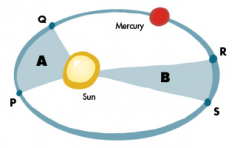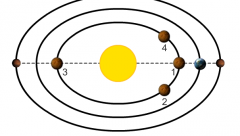![]()
![]()
![]()
Use LEFT and RIGHT arrow keys to navigate between flashcards;
Use UP and DOWN arrow keys to flip the card;
H to show hint;
A reads text to speech;
24 Cards in this Set
- Front
- Back
- 3rd side (hint)
|
True or False: Most of the names of the brightest stars are of Arabic origin.
|
True; Most of the names of the brightest stars are of Arabic origin. Go back and reread the section on the Dark Ages.
|
|
|
|
Aphelion is the point in a planetary orbit at which the planet is...?
|
Farthest from the sun.
|
|
|
|
What was the greatest contribution of Tycho Brahe to astronomy?
|
He amassed a large number of precise measurements of stellar and planetary positions in the sky.
|
|
|

Refer to the figure. Suppose Mercury takes twenty–one days to move from position P to position Q, and eighteen days to move from position R to position S. What do you know about the areas A and B?
|
A is bigger than B
|
|
|

What is position 1 called?
|
Inferior conjunction
|
|
|
|
True or False: When Saturn is at opposition we cannot see it because it is hiding behind the Sun.
|
False; Opposition means the planet and the Sun are on opposite sides of Earth. Thus, we could see Saturn high in the sky at midnight, when it is at opposition.
|
|
|
|
Nicholas Copernicus was the first modern astronomer to believe in....?
|
A heliocentric universe.
|
|
|
|
Johannes Kepler theorized that...?
|
That planets do not move at uniform speeds throughout their orbits
|
|
|
|
Galileo Galilei was the first astronomer to...?
|
Use a telescope.
|
|
|
|
Tycho Brahe tried to...?
|
Prove heliocentric universe was wrong.
|
|
|
|
Eratosthenes calculated...?
|
The circumference of the Earth.
|
|
|
|
Aristotle created the theory of...?
|
The universe with two types of motion: towards away from and around.
|
|
|
|
Ptolemy invented...?
|
Epicycles to explain retrograde motion.
|
|
|
|
Aristarchus believed...?
|
That the Sun was at the center of the universe.
|
|
|
|
Which of the following is not one of the major astronomical discoveries made by Galileo?
A.Jupiter is orbited by moons. B. The shape of a planet's orbit is an ellipse. C. The Moon has mountains, valleys, and craters. D. Venus goes through phases. E. The Sun has spots and rotates. |
B. The shape of a planet's orbit is an ellipse.
|
|
|
|
True or False: Planets do not orbit the Sun in perfectly circular orbits.
|
True; As Kepler pointed out, planetary orbits are actually ellipses, not circles.
|
|
|
|
True or False: The synodic period is the amount of time for a planet to move from one configuration to the next identical configuration.
|
True; Recall that the synodic period is based on Earth–bound observation, and the sidereal period is based on an outside perspective.
|
|
|
|
True or False: All early astronomers before Copernicus believed that the world was flat.
|
False; Recall that ancient Greek astronomers, such as Aristotle and Eratosthenes, believed the earth was a sphere.
|
|
|
|
True or False: Epicycles are smaller spheres attached to the larger deferents.
|
True; Ptolemy invented epicycles to explain retrograde motion. Epicycles are smaller spheres attached to the larger deferents.
|
|
|

What is this constellation?
|
Canis Major.
|
|
|
|
Who proposed the idea that gravity could actually bend light?
|
Albert Einstein
|
|
|
|
True or False: People of ancient Greece believed the world was shaped like a sphere.
|
True; Aristotle concluded that Earth must be a sphere. Eratosthenes measured the circumference of Earth.
|
|
|

What is the bright star shown in this constellation?
|
Sirius.
|
(Constellation: Canis Major) |
|
|
True or False: Planets in orbits closer to the Sun move faster than planets in orbits further away.
|
True; Remember Kepler's Second Law: the area swept out by a planet will be equal for equal times. One result of this is that the closer planets are to the Sun, the faster they move in their orbits.
|
|

